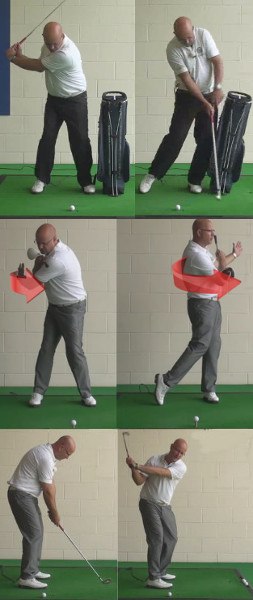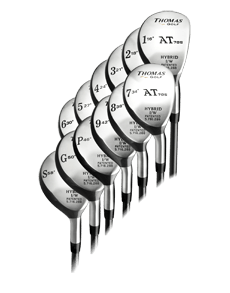
 One of the best ways to make progress in your golf game is to understand the common problems that you need to watch for with regard to whatever you are working on at the moment. In this case, it is chest rotation, and there are a few problems which will frequently pop up when trying to improve your performance in this area. As you practice your chest rotation, watch out for signs of any of the mistakes listed below.
One of the best ways to make progress in your golf game is to understand the common problems that you need to watch for with regard to whatever you are working on at the moment. In this case, it is chest rotation, and there are a few problems which will frequently pop up when trying to improve your performance in this area. As you practice your chest rotation, watch out for signs of any of the mistakes listed below.
- Loss of balance due to over rotation. There is a real risk of overdoing it when trying to improve your chest turn. Yes, you want to make a full turn in order to maximize your swing speed through impact, but going too far can throw your swing off track.
- Specifically, you are likely to fall off balance if you force yourself to turn farther than you can turn comfortably. By going beyond the comfortable limits of your flexibility, you will probably lean to the right at the top of your swing, and it will be nearly impossible to recover from there.
- The best way to avoid this mistake is simply to be aware of it. Pay attention to your balance and dial back your chest rotation if you feel yourself getting out of control. Balance is one of the most important fundamentals in your swing, and it is not worth sacrificing your balance in order to make a bigger turn. Instead, you should be trying to make the biggest turn possible within the confines of your ability to remain balanced.
- Mechanical tempo. While it is important to make a big turn, you also need to remember to maintain the rhythm and feel of your golf swing. As mentioned earlier, making a big chest turn can help your tempo, but only if you approach this topic from the right direction.
- You don’t want to swing like a robot, forcing your body to turn back and then through in a mechanical manner. Rather, you want to have a smooth rhythm to your action, turning back and through with great tempo. If you feel like your swing is becoming too mechanical, try to soften up your arms at address.
- Relax the muscles in your shoulders and arms and let the club swing freely while still using your chest to make a big turn. Once you strike the right balance, your swing will feel smooth, yet powerful.
- Potential for a hook. As you already know, countless amateur golfers struggle with a slice. The slice is such a common ball flight problem because most players fail to make a good turn. Without a good turn away from the ball, the club will end up over the ideal swing plane, and it will come down on an outside-in path.
- When that happens, a slice is nearly inevitable. So, if you do manage to make a big chest turn, you will be safely away from slice territory – but you may flirt with a hook as a result. If you let your arms drop too far at the top of the swing, you’ll wind up coming into the ball dramatically from the inside.
- That means you will be hitting from inside-out, and hook spin is going to be produced. Sometimes, this kind of swing will produce a gentle draw, while other times it will result in a nasty hook. To maintain control of your ball flight while using a big chest turn, make sure to keep your arms in sync with your upper body. As long as your arms don’t drop dramatically at the top, you shouldn’t have any trouble staying away from hook territory.
There are no perfect moves in the golf swing. Everything you do in golf is a tradeoff, sacrificing something in order to gain something else. This is certainly true when it comes to chest rotation. Yes, you can add power to your swing when you make a big turn, but you also will run the risk of hitting a hook or falling off balance. As you practice, watch out for any signs of trouble and take steps to correct your errors before they become too serious.
Golf swing rotation problems can lead to various issues in your swing and impact your overall performance. Here are a few common rotation problems and some potential solutions:
- Lack of Hip Rotation: Insufficient hip rotation can limit your ability to generate power and lead to a loss of distance. To address this issue, focus on proper hip rotation during your swing. Start by ensuring your setup includes a slightly open stance with your feet, hips, and shoulders aligned. During the backswing, rotate your hips away from the target while maintaining stability in your lower body. On the downswing, initiate the rotation of your hips toward the target, allowing your upper body to follow through naturally.
- Over-rotation or “Reverse Pivot”: Over-rotation occurs when your upper body turns too much on the backswing, causing a loss of power and stability. It often leads to inconsistent strikes and poor ball contact. To address this, focus on maintaining a balanced and centered pivot during your swing. Keep your weight centered between your feet throughout the swing and avoid excessive lateral movement or swaying. Focus on a controlled and coordinated turn of your shoulders and hips while maintaining stability.
- Early or Late Release: The timing of your release can greatly impact the accuracy and power of your shots. Releasing the club too early can lead to slices or weak shots, while a late release can result in hooks or a lack of distance. To improve your release, focus on maintaining proper sequencing in your swing. Initiate the downswing with your lower body, allowing the rotation of your hips and torso to lead the movement. Let your arms and club naturally follow the body's rotation, leading to a well-timed release through impact.
- Limited Shoulder Turn: Insufficient shoulder turn can restrict your swing arc and lead to a lack of power and accuracy. To improve shoulder turn, work on flexibility exercises that target your shoulders, back, and torso. Prioritize a full and unrestricted shoulder turn during your backswing, allowing your lead shoulder to rotate under your chin. This will help maximize your swing arc and generate more power.
- Inconsistent Spine Angle: Inconsistent spine angle during the swing can cause inconsistency in ball striking and accuracy. Maintain a consistent spine angle throughout your swing by focusing on good posture and alignment at setup. Avoid excessive bending or straightening of your spine during the swing. Practice drills that promote a stable spine angle, such as swinging with a golf club across your shoulders while maintaining a steady posture.
It's important to note that working with a qualified golf instructor or coach can provide personalized guidance and help identify specific rotation problems in your swing. They can provide tailored drills, exercises, and feedback to address your individual swing issues and help you make the necessary improvements.
Update: Golf Swing Rotation Problems:
- Lack of Shoulder Turn:
- Incomplete rotation of the shoulders can limit the power and distance of the swing.
- Over-rotation of Hips:
- Excessive hip rotation can lead to loss of balance and inconsistent ball striking.
- Early Hip Movement:
- Initiating hip rotation too early in the downswing can cause a loss of power and accuracy.
- Limited Torso Rotation:
- Inadequate torso rotation can result in a flat swing plane and reduced clubhead speed.
- Hip Slide Instead of Rotation:
- Sliding the hips laterally instead of rotating them can lead to a lack of power transfer and inconsistent contact.
- Reverse Spine Angle:
- A reverse spine angle, where the upper body tilts away from the target at impact, can cause a loss of power and accuracy.
- Loss of Posture:
- Failing to maintain proper posture throughout the swing can hinder rotation and lead to inconsistent ball striking.
- Limited Lower Body Engagement:
- Insufficient engagement of the lower body in the downswing can result in an arms-dominated swing and lack of power.
- Inadequate Weight Shift:
- Failing to shift weight properly from back foot to front foot can limit rotation and lead to inconsistent strikes.
- Swaying Off the Ball:
- Swaying the body away from the target during the backswing can disrupt rotation and lead to poor contact.
10 Q&A On Golf Swing Rotation Problems:
- Q: How can I improve shoulder turn in my swing?
- A: Focus on flexibility exercises to improve shoulder mobility and practice drills that emphasize a full shoulder turn in the backswing.
- Q: What causes early hip movement, and how can I fix it?
- A: Early hip movement often stems from poor sequencing. Work on initiating the downswing with the lower body while maintaining upper body coil in the backswing.
- Q: How do I prevent over-rotation of the hips?
- A: Focus on maintaining stability in the lower body while allowing for controlled rotation. Strengthening the core muscles can also help stabilize hip movement.
- Q: What are some drills to improve torso rotation?
- A: Practice drills that focus on separation between the upper and lower body, such as the “X-Factor” drill or the “Towel under Arms” drill.
- Q: How can I ensure proper weight shift in the swing?
- A: Work on drills that promote weight transfer from back foot to front foot during the downswing, such as the “Step Drill” or the “Feet Together Drill.”
- Q: What's the best way to address reverse spine angle?
- A: Focus on maintaining a stable spine angle throughout the swing. Strengthening the core muscles and improving flexibility can help prevent reverse spine angle.
- Q: How do I know if I'm swaying off the ball during the swing?
- A: Use video analysis or work with a coach to identify any lateral movement away from the target during the backswing. Focus on maintaining stability in the lower body.
- Q: Can limited lower body engagement affect my swing power?
- A: Yes, the lower body plays a crucial role in generating power in the golf swing. Practice drills that emphasize lower body rotation and weight transfer for more power.
- Q: Is it possible to fix rotation problems on my own, or do I need professional help?
- A: While self-awareness and practice can address some rotation issues, working with a qualified instructor can provide personalized guidance and feedback for faster improvement.
- Q: How long does it typically take to correct rotation problems in the golf swing?
- A: The time it takes to correct rotation problems varies depending on individual factors such as athleticism, flexibility, and practice frequency. Consistent practice and feedback are key to improvement.





